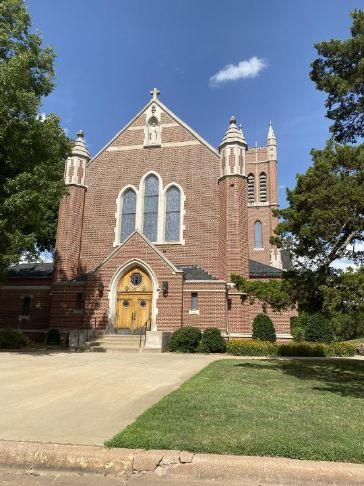At the Shawnee City Commission’s June meeting, Shawnee Engineering Director Seth Barkhimer offered an update on an issue with the Twin Lake No. 1 dam, as well as the steps being taken to address it.
Inspections
In general, both lakes are evaluated annually by staff and a third-party consultant, he said.
There are three designations for dams: low hazard; significant hazard; and high hazard.
“The designation changes what agencies, like the city, are required to do in the way of inspections and their frequency of inspection,” he said. “Our lakes are considered high-hazard lake dams – the highest classification for dams.”
He said there are several factors that give them that designation.
“Based on the FEMA definition, high hazard potential is a designation for any dam that’s failure or mis-operation will cause loss of life or significant property destruction,” he said. “So, factors that play into the designation are dam height; the amount of water it’s holding back; the amount of development that takes place downstream, etc.”
What the designation does for Shawnee is it creates a requirement for the city to complete and submit inspections of the dam to OWRB annually.
“So, every year, we hire a third-party consultant to do a full inspection; that inspection report is sent to OWRB and then we get an approval letter back from the resources board that we’ve met our obligation – or that we’re lacking in any way,” he said, adding the board will issue further directions if the city is lacking.
Barkhimer said Shawnee usually gets its inspections in the fall – typically in September or October.
Lake No. 1
“In 2018, Terracon, who did our inspection, identified a depression in the pavement just east of the spillway,” he said. “It’s right before you go on the spillway bridge as you’re headed to the west.”
At that time, he said the maintenance recommendation was to watch the area more closely, and if possible, seal the area.
“In ’19 and ’20, we had the same,” he said. “The dip progresses and elongates linearly down the road; in 2021, we have the same pavement dip, but this time (the report) adds in some additional language on the upstream slope.”
Reading from the report, Barkhimer cited the findings, “A slippage crack has developed in the upstream slope, resulting in a depressed section about midway along the length of the dam. We recommend addressing the area before the depression and the crack develop further … and a more in-depth geotechnical investigation may be warranted to develop a long-term solution to the issue.”
Barkhimer said after the city received that report, his department applied for a high-hazard dam grant through OWRB; that specific grant pays for a field investigation and design for dams that have issues that come up before inspection reports and fall within the (grant) category, he said.
“To be eligible for the grant and future ones in the program, we had to add some specific language to our hazard mitigation plan,” he said. “So, in early 2023, we were able to amend our current hazard mitigation plan with the county and complete some field investigation or geotechnical work.”
He said in parallel with the hazard mitigation plan amendment process, late in 2022 the city got a proposal from Terracon to do field investigation and geotechnical work in the area of the roadway depression.
“In mid-2023, I think it was July, Terracon completed some of its geotechnical field work and briefed city staff and the OWRB on what they are seeing in the field,” he said. “Based on the findings, OWRB issued an emergency order – that emergency order informed us on what our next steps would be.”
In summary, he said it’s a list to consult with engineering staff experienced in dam safety, and complete additional studies, and submit those results to OWRB once they are completed.
“The geotechnical firm, Terracon, found something worthy of further investigation and the resulting data was to be reviewed and interpreted by a specialty engineer,” Barkhimer explained. “While the geotech investigation was underway in November 2023, the OWRB issued an official consent order, and the difference between an emergency order and consent order is the fact that the consent order actually passes through the OWRB, while the earlier emergency order is issued by staff.”
He said the consent order had a lot of the same language as the emergency order, but also expanded on some requirements for interim production measures.
“OWRB wanted to make sure we assessed the potential risks and were prepared to respond,” Barkhimer said. “In late February 2024, Terracon issued its geotechnical engineering report with provided data for the entirety of the Lake No. 1 dam.”
At the same time, he said the Army Corps of Engineers helped the city prepare a battle sheet – which establishes triggers for response and establishes lines of communication.
“Also in February 2024, the Army (Corps of Engineers) issued a trip report — they came down to visually inspect the dam and issue a short report on what they see and the action that they recommend in the short-term,” he said. “In March 2024, with the geotechnical report, we issued a request for qualifications for professional engineering services for engineers who have experience in dam safety.”
Barkhimer said his department received multiple responses.
Staff interviewed prospective firms, he said, adding that phase of the process was on the June agenda.
What’s next?
Barkhimer said among next steps in the process are hiring a dam safety expert (specialty engineer); developing recommendations and a project plan; securing funding; and then putting the plan into action.
Background
Planning for Lake No. 1 was started in the early 1930s, Barkhimer said, and the dam itself was constructed in 1935.
“Lake No. 1 was initially built to provide a viable water supply for a growing population in Shawnee,” he said. “Over the years the lake has seen several improvements and expansions to meet increasing demands, including in 1960 when Lake No. 2 was constructed.”
The lakes were connected by an equalization channel in 1962, he said.
“The lakes have become more than just a water supply,” Barkhimer said. “It has developed into a recreational area, offering various activities, such as fishing, boating and camping.”
There are currently two parks on Lake No. 1: Isaac Walton, on the east side; and Glen Collins Memorial Park on the west side.
Watch for updates.




